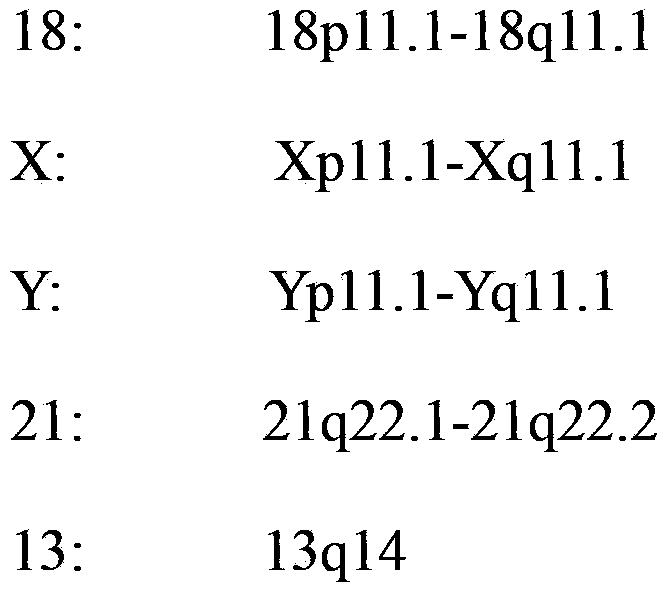Fluorescence in-situ hybridization method capable of improving covariance
A technique of fluorescence in situ hybridization, specimen
- Summary
- Abstract
- Description
- Claims
- Application Information
AI Technical Summary
Problems solved by technology
Method used
Image
Examples
Embodiment 1
[0039] An improved co-denaturation fluorescence in situ hybridization method, comprising the following steps:
[0040] Step 1 Preparation of slide specimens:
[0041] The pretreated samples are placed in EP tubes;
[0042] Add 1mL EDTA-trypsin to digest in 37°C water bath for 15min, centrifuge, and discard the supernatant;
[0043] Add 1mL of hypotonic solution to the precipitate, and bathe in water at 37°C for 15min;
[0044] Add 2mL of fixative to pre-fix and mix well, centrifuge and discard the supernatant;
[0045] After adding 2 mL of fixative to fix and mix well, fix at room temperature for 5 min, centrifuge, and discard the supernatant;
[0046] Take the remaining cell suspension, drop the slices, and bake the slices at 65°C for 15 minutes to prepare slide specimens;
[0047] Step 2: Probes covariate and hybridize with chromosomes:
[0048] Add 8 μL of probe solution dropwise to the cell area of the slide specimen, add a cover slip, and drive away the air bubbles...
Embodiment 2
[0060] An improved co-denaturation fluorescence in situ hybridization method, comprising the following steps:
[0061] Step 1 Preparation of slide specimens:
[0062] The pretreated samples are placed in EP tubes;
[0063] Add 2 mL of EDTA-trypsin to digest in a 37°C water bath for 30 min, centrifuge, and discard the supernatant;
[0064] Add 2mL of hypotonic solution to the precipitate, and bathe in water at 37°C for 20min;
[0065] Add 1mL of fixative solution to pre-fix and mix well, centrifuge and discard the supernatant;
[0066] After adding 1mL of fixative to fix and mix well, fix at room temperature for 7min, centrifuge, and discard the supernatant;
[0067] Use the remaining cell suspension, drop the slices, and bake the slices at 60°C for 20 minutes to prepare slide specimens;
[0068] Step 2: Probes covariate and hybridize with chromosomes:
[0069] Add 10 μL of probe solution dropwise to the cell area of the slide specimen, add a cover slip, and drive away t...
Embodiment 3
[0081] An improved co-denaturation fluorescence in situ hybridization method, comprising the following steps:
[0082] Step 1 Preparation of slide specimens:
[0083] The pretreated samples are placed in EP tubes;
[0084] Add 2 mL of EDTA-trypsin to digest in a 37°C water bath for 20 min, centrifuge, and discard the supernatant;
[0085] Add 1.5mL hypotonic solution to the precipitate, and bathe in water at 37°C for 15min;
[0086] Add 2mL of fixative to pre-fix and mix well, centrifuge and discard the supernatant;
[0087] After adding 2 mL of fixative to fix and mix well, fix at room temperature for 5 min, centrifuge, and discard the supernatant;
[0088] Use the remaining cell suspension, drop the slices, and bake the slices at 70°C for 10 minutes to prepare slide specimens;
[0089] Step 2: Probes covariate and hybridize with chromosomes:
[0090] Add 8 μL of probe solution dropwise to the cell area of the slide specimen, add a cover slip, and drive away the air bu...
PUM
 Login to View More
Login to View More Abstract
Description
Claims
Application Information
 Login to View More
Login to View More - R&D
- Intellectual Property
- Life Sciences
- Materials
- Tech Scout
- Unparalleled Data Quality
- Higher Quality Content
- 60% Fewer Hallucinations
Browse by: Latest US Patents, China's latest patents, Technical Efficacy Thesaurus, Application Domain, Technology Topic, Popular Technical Reports.
© 2025 PatSnap. All rights reserved.Legal|Privacy policy|Modern Slavery Act Transparency Statement|Sitemap|About US| Contact US: help@patsnap.com

